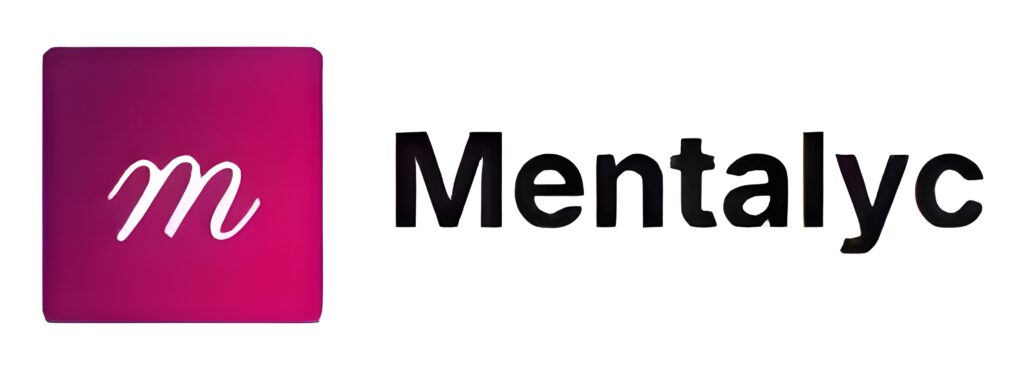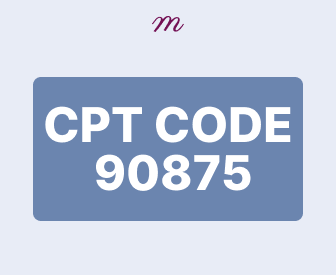Have your progress notes written for you automatically
Incorrect Current Procedural Terminology (CPT) code usage and documentation errors cost mental health care providers thousands of dollars annually. One of the most complex codes to bill correctly is CPT code 90875. This is specifically for psychophysiological therapy with biofeedback.
Learning the correct protocols for this code can revolutionize your practice, improve your reimbursement rates, and deliver the best possible care for your clients.
Understanding CPT Code 90875: Description and Core Components
CPT Code 90875 falls under "Other Psychiatric Services." This code represents a specialty that merges psychophysiological therapy with biofeedback training and psychotherapy. These treatments must last 30 minutes and include face-to-face interaction between you and your client or via telehealth.
Key Elements of Psychophysiological Therapy and Biofeedback
Psychophysiological therapy connects classical psychological therapies and state-of-the-art monitoring and feedback capabilities. In these sessions, clients learn to identify and alter their physiological reactions to stress, anxiety, and other emotional arousal by immediate feedback about bodily functions:
- Heart rate
- Muscle tension
- Temperature changes
- Breathing
Documentation Requirements and Best Practices in Using CPT Code 90875 Effectively
Accurate documentation ensures reimbursement of services billed under CPT code 90875. Documentation requirements for medical necessity exist for both Medicare and other payers. The first step in meeting these medical necessities is documenting your client's treatment needs.
Medical Necessity Documentation Must Include:
- Entire medical and psychiatric history
- Results of the mental status examination
- Initial diagnosis
- Treatment plan with expected outcomes
- Client's ability to engage in the treatment
For example, you may document how breathing exercises with biofeedback monitoring were combined with cognitive restructuring to address your client's anxiety symptoms. This detailed documentation not only ensures proper billing but also provides a clear record of your client's progress and the effectiveness of the treatment plan.
Session Length Requirements
Session length is another critical element of correct documentation. Each session should be about 30 minutes divided into:
- 20-25 minutes of direct patient contact
- 5-10 minutes for documentation and set up of equipment
CPT Code 90875 Reimbursement and Billing Strategies
The reimbursement rates of CPT code 90875 depend upon many variables, including insurance partnerships and geographic location. Knowledge of these variables will help health practitioners to ensure that their billing is correct and their revenues are optimized.
Some of the major factors of reimbursement rates variable pricing include the following:
Insurance Plan Types
- Insurance companies negotiate different rates for the same CPT codes, including private insurance, Medicare/Medicaid, and self-pay rates.
Geographic Location
- Reimbursement may also be based on the location of service provision, with different rates for urban and rural areas. Individual state requirements and regional cost factors may influence this.
Client Demographics
- The type of clients treated, including age and medical necessity, can also influence how services are reimbursed under different insurance plans.
Documentation Strategies to Optimize Reimbursement Potential
To optimize your reimbursement potential, try these documentation strategies:
- Use specific, measurable language
- Record subjective and objective data
- Note any equipment or instruments utilized
- Document patient education provided
- Include planned interventions for future sessions
Pre-Authorization Requirements
Most insurances require pre-authorization for biofeedback services. Call the insurance carrier and confirm the following:
- Number of authorized visits
- Coverage limits
- Patient copay responsibilities
- Specific documentation requirements
Common Insurance Coverage Issues
The most common reasons an insurance company denies insurance coverage include:
- Lack of medical necessity documentation
- Improper coding combinations
- Lack of pre-authorization
- Exceeding the number of authorized visits
Simplification of the verification process prevents claims denial and facilitates proper reimbursement for services under CPT Code 90875.
Modifiers, Frequency Guidelines, and Session Limits for CPT Code 90875
Understanding modifiers and frequency guidelines for CPT Code 90875 helps ensure accurate billing and optimal treatment planning.
Common Modifiers for CPT Code 90875:
Recognizing modifiers and frequency guidelines for CPT code 90875 can facilitate accurate billing and treatment planning. Common modifiers include:
- 25: Used when a separately identifiable, significant evaluation and management service is provided on the same day
- 59: Indicates a separate procedural service
- 95: Synchronous telemedicine services furnished via real-time audio and video
- GT: Telehealth services provided through audio and video
Session Frequency Guidelines:
Initial Treatment Phase: Sessions can be conducted 2-3 times weekly for 4-6 weeks. This frequency establishes baseline measurements and helps clients develop basic self-regulation skills.
Maintenance Phase: After the initial phase, clients usually go on to one session per week. The length of this phase is at the discretion of the client's progress and specific treatment goals.
Session Limits and Authorization: Most insurance companies have specific limits on the number of available sessions. These usually range between 20 and 30 sessions in a calendar year. Further visits are possible only if prior authorization is obtained correctly.
Mastering CPT code 90875
The mastery of CPT code 90875 is not just a technical requirement, it is a journey of transformation that empowers your mental health practice and ensures fair compensation for the invaluable service you provide. By embracing accurate coding, you are protecting your professional integrity and opening the door to maximum reimbursement opportunities that will grow and sustain your practice.
Advanced treatments, such as biofeedback and psychotherapy, require precise record-keeping and detailed billing. Your good charting, along with understanding some of the nuances of billing and current coding, is the backbone of your practice. Remember, it is not all about compliance; it's about quality care that makes a real difference in your client's life.
Mentalyc and other tools of this nature will be your ally in this, easing it even more with streamlined documentation. This will give you the time to focus on what matters most—your clients' mental health and well-being. By signing up for a free trial, you’ll advance your practice by adding fullness to the lives of those you serve.
Mastery of CPT code 90875 is about attention to detail in several components of healthcare delivery. Proper documentation is your bedrock, and maintaining provider qualifications ensures you deliver the highest quality of care. Documenting medical necessity, adhering to precise timing, and following treatment protocols are critical to protecting patient outcomes and your practice's compliance.
It's all about success with three critical elements: ensuring comprehensive documentation to meet all clinical and regulatory requirements, committing to ongoing certification maintenance, adding knowledge about specific state compliance requirements, and using strategic billing coupled with tight insurance verification to maximize reimbursement potential.
Audit preparation requires vigilance through regular internal reviews and robust documentation defense strategies. Integrating treatment planning through collaborative care management can significantly enhance service delivery and support positive patient outcomes. Instead of focusing on the goal of symptom resolution alone, focus on preventing deterioration and fostering continuous functional improvements through measurable progress tracking.
Conclusion
Following these principles will place the healthcare provider in a very optimal position for reimbursement and effective psychophysiological therapy via biofeedback. Although these requirements may seem daunting, following these best practices in a methodical manner will protect not only your practice but will also enhance patient care. Take ownership of this process with pride, and your practice will flourish, touching your clients' lives in many ways.
Your Most Frequently Asked Questions About CPT Code 90875
What is CPT Code 90875?
CPT Code 90875 involves individual psychophysiological therapy that merges biofeedback into the treatment process affecting mental health. This code shows that the approach toward the therapy is holistic, where there is indeed a fusion of psychological and physiological approaches to yield better outcomes.
What are the key components required for using CPT Code 90875?
There are some key components to using CPT Code 90875. Medical biofeedback techniques should be incorporated into standard psychotherapy. A session must be at least 30 minutes long, and the therapy must be evidence-based. For example, cognitive-behavioral treatment, to treatment ensures effectiveness and adherence to medical insurance requirements.
How do mental health providers get reimbursed properly for CPT Code 90875?
To secure adequate reimbursement when using CPT Code 90875, mental health professionals need to take the lead in being aware of insurance details that cover CPT Code 90875, such as verifying clients' respective insurance plans before billing and understanding the variables for reimbursement. Similarly, proper documentation should be provided, which is critical when filling with insurance companies.
What documentation is required when using CPT Code 90875?
Proper documentation during billing is essential for CPT Code 90875. Good case notes will enable the mental health professional to indicate biofeedback methods used during treatment, specify psychotherapy techniques utilized during a session, and provide relevant patient information to justify billing. This is helpful not only for reimbursement purposes but also for clinical accountability.
What best practices should mental health professionals follow when using CPT Code 90875?
To make the most of CPT Code 90875, the following best practices should be observed: appropriately incorporating biofeedback into treatment, educating patients regarding the treatment process, and building transparency regarding the consequences of billing, among other general best practices for mental health. Additionally, proper documentation will help with claims and foster a more efficient practice and an increased quality of care for patients.
Following these guidelines and best practices will enable mental health professionals to confidently navigate the complexities surrounding CPT Code 90875, provide adequate care, and properly compensate themselves for their work.
Resources
Bhatia, M. (2024, September 8). Top Counseling CPT Codes. Healthie. https://www.gethealthie.com/blog/top-counseling-cpt-codes
Bhatnagar, R. (2024, December 12). Psychotherapy Medical Billing & Coding Guide for 2024. Neolytix. https://neolytix.com/psychotherapy-medical-billing-coding-guide/
How to Use the 90875 CPT Code in Mental Health Billing. (2024, July 5). Doctor Papers. https://doctorpapers.com/90875-cpt-code-in-mental-health-billing/
Medisys. (2023, July 10). Understanding Modifiers for Mental Health Billing. https://www.medisysdata.com/blog/understanding-modifiers-for-mental-health-billing/
My Clients Plus. (2024). Foolproof Guide to Mental Health Billing Codes. EHR for Mental Health Practices. https://myclientsplus.com/foolproof-guide-to-mental-health-billing-codes/
Successful Practitioner. (n.d.). CPT Billing Codes For Reimbursement. https://www.successful-practitioner.com/bio-neurofeedback-qeeg-billing-cpt-codes










